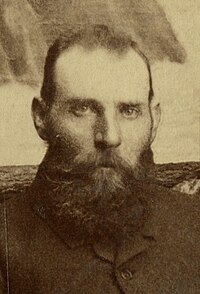William Stafford (mining engineer)
William Stafford (November 15, 1842 - May 12, 1907) was a coal mining engineer and mine superintendent for the North Western Coal and Navigation Company who was responsible for determining the location of the City of Lethbridge, Alberta, Canada.
Personal life
William Stafford was born in Patna, Ayrshire, Scotland, on November 15, 1842. He was the only son of William Stafford, an English mining engineer and geologist, and Margaret Findlay Stafford.[1] On December 31, 1863, he married Jane Gibb of Auchinleck, Ayrshire, Scotland, whose brother David Gibb became a prominent contractor in British Columbia.[2] While residing in Auchinleck, William and Jane Stafford had three sons: William, Jr., Henry, and John. They then emigrated to Westville, Nova Scotia, in 1871, where they had five additional sons (Richard, Alexander, George, David, and James) and two daughters (Agnes and Margaret). In 1883, the family moved to the area that later became Lethbridge, Alberta, where they had an additional son (Elliott) and two additional daughters (Henrietta, the first white child born in the area, and Annie Laurie). The Staffords constructed a large ranch house on the bottomlands of the Belly River River which became a major community and social center.[1]
Career
After an education in Scotland, William Stafford became the manager of coal mines operated by the Acadia Coal Company of Pictou in Nova Scotia, and he continued in that capacity until 1882.[3] In that year, he was hired by Sir Alexander Galt as manager and mine superintendent for the North Western Coal and Navigation Company to assess coal mining opportunities in the West. After investigating a number of possibilities, Stafford and his companion Captain Nicholas Bryant focused on Coal Banks on the Belly River due to the high quality of coal in that region. It was William Stafford who made the final decision as to the location of Drift Mine No. 1, which ultimately determined the location of the City of Lethbridge.[4] In 1894, Stafford became Inspector of Mines for the company but then later resigned to pursue ranching and real estate interests. In order to provide accommodations for the increasing number of miners who were coming to the area, William Stafford purchased an area of land that became known as Staffordville, which he developed into lots for miners' houses.[1] Stafford maintained an interest in coal mining, and at the time of his death, he was operating a private coal mine near Carmangay, north of Lethbridge.
Death and legacy
William Stafford died on May 12, 1907, and was buried in the family plot in Mountain View Cemetery in Lethbridge.[5] Following his death and the Belly River flood of 1908, the Stafford family moved into the city of Lethbridge.[1]
A collection of historic photographs, documents, and personal items of William Stafford and his family is currently housed in the Galt Museum & Archives in Lethbridge. The section of north Lethbridge known as Staffordville (built around the No. 3 coal mine) as well as Stafford Drive and Stafford Place (a 10-story residential building) in Lethbridge were named in William Stafford's honor.[1] A plaque honoring William Stafford and other coal pioneers, donated by the Lethbridge Miner's Library Club in collaboration with the Lethbridge Historical Society, was unveiled in Indian Battle Park on September 2, 1963. Entitled "Here We Begin to Mine the Coal," the plaque reads in part: "In 1882, William Stafford chose this place for the North West Coal and Navigation Company to begin mining coal, thus determining the location of Lethbridge."[6]
References
- ^ a b c d e Peat, Annie Laurie Stafford; Johnston, Alex; Steward, Carlton R. (1978). Nineteenth century Lethbridge. Lethbridge, Alta: Whoop-Up Country Chapter, Historical Society of Alberta. Retrieved 4 April 2017.
- ^ Scholefield, Ethelbert Olaf Stuart; Howay, Frederick William (1914). 'British Columbia from the earliest times to the present. Vancouver, B. C.: The S.J. Clarke Publishing Company. Retrieved 21 January 2016.
- ^ Johnston, Alex; Gladwyn, Keith G.; Ellis, L. Gregory (1989). Lethbridge, its coal industry. Lethbridge, Alta: Lethbridge Historical Society. Retrieved 21 January 2016.
- ^ Johnston, Alex; den Otter, Andy A. (1985). Lethbridge: a centennial history. Lethbridge, Alta: City of Lethbridge and the Whoop-Up Country Chapter, Historical Society of Alberta. Retrieved 21 January 2016.
- ^ William Stafford at Find a Grave
- ^ "Here We Begin to Mine the Coal". Retrieved 4 April 2017.

